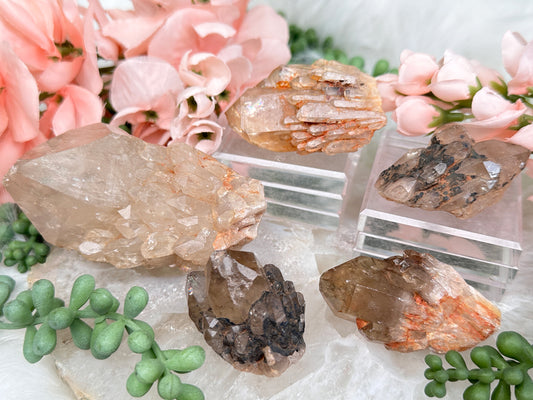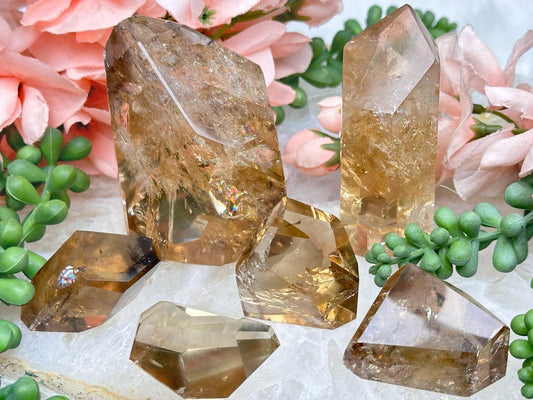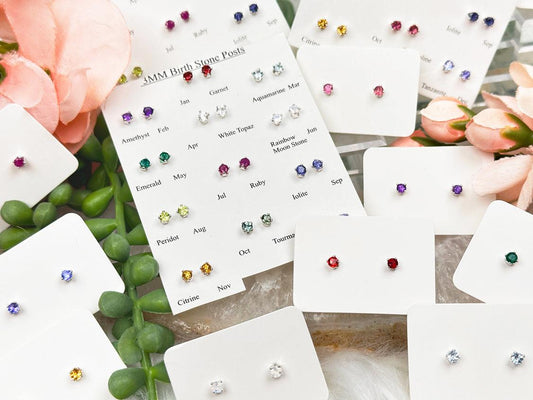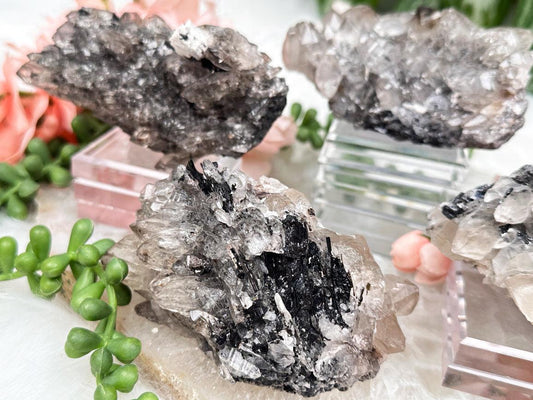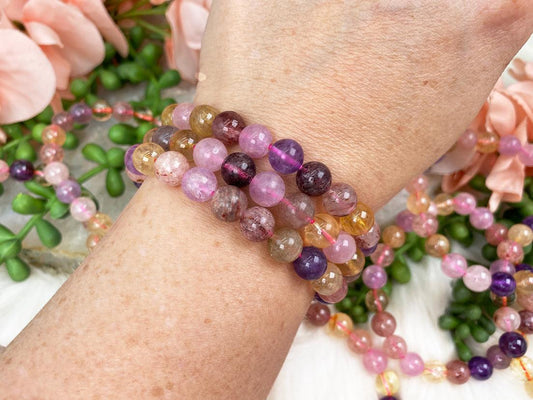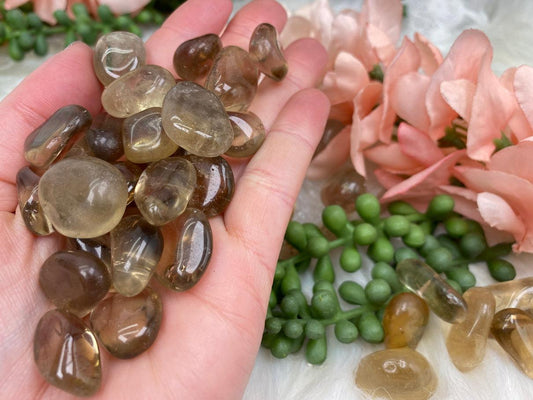Citrine crystal, a fairly rare stone, is a cheerful and bright crystal coveted by collectors and crystal enthusiasts due to its positive energy and association as a crystal for prosperity. Citrine possesses a translucent tan to yellow coloring, but can sometimes even have a brown hue. Natural citrine meaning is believed to have the power of the sun and symbolizes happiness, growth and positivity among other uses. Learn about the citrine crystal meaning at the bottom of the page.
-
Congo Citrine Clusters
Regular price $30 - $95Regular priceUnit price per -
Polished Citrine
Regular price $18 - $185Regular priceUnit price per -
Brazil Citrine Points
Regular price $13 - $43Regular priceUnit price per -
Beaded Necklaces
Regular price $24 - $30Regular priceUnit price per -
925 Silver Faceted Amethyst & Citrine Rings
Regular price $35 - $38Regular priceUnit price per -
925 Silver Crystal Birthstone Earrings
Regular price $22.00Regular priceUnit price per -
Old Stock Tourmalinated Citrine
Regular price $120 - $175Regular priceUnit price per -
Citrine Pendants
Regular price $27 - $42Regular priceUnit price per -
Ametrine Rings
Regular price $49 - $68Regular priceUnit price per -
Quartz Animal Carvings
Regular price $17 - $36Regular priceUnit price per -
Morocco Citrine Clusters
Regular price $5 - $42Regular priceUnit price per -
Citrine Necklace
Regular price $28.00Regular priceUnit price per -
Whale Crystals
Regular price $22 - $55Regular priceUnit price per -
Natural Citrine Cabochons
Regular price $15 - $20Regular priceUnit price per -
Natural Citrine Faceted Gems
Regular price $16 - $36Regular priceUnit price per -
Brazilian Citrine Double Points
Regular price $26 - $120Regular priceUnit price per -
Brazilian Citrine Points
Regular price $14 - $35Regular priceUnit price per -
Super 7 Bracelet
Regular price $24.00Regular priceUnit price per -
Tumbled Smoky Citrine
Regular price $3 - $6Regular priceUnit price per -
Morocco Citrine Crystals
Regular price $11 - $32Regular priceUnit price per -
Raw Citrine Crystal Jars
Regular price $8.00Regular priceUnit price per -
Polished Citrine Points
Regular price $17 - $25Regular priceUnit price per -
Natural Citrine Point Crystals
Regular price $12 - $19Regular priceUnit price per -
Heated Citrine Bracelets
Regular price $6.00Regular priceUnit price per

Citrine crystal is a captivating crystal known for its distinctive golden hues, often likened to the warmth of the sun. This beautiful gemstone is a variety of quartz with a unique geological history. It forms deep within the Earth's crust, usually in association with amethyst, another quartz variety. Citrine crystal's formation is a result of a combination of heat, pressure, and the introduction of iron during its growth process. Over millions of years, these natural forces work together to create the stunning, golden tones that define citrine. Its mineral composition, primarily composed of silicon dioxide, makes it a highly desirable gemstone for both its striking appearance and its geological significance.
Natural citrine is durable and scratch resistant which is why it is commonly used in jewelry and engravings. It’s a hard stone and is rated 7 on the Mohs scale. It is also a November birth stone and also a symbolic gemstone for the 13th wedding anniversary.
What does citrine look like?

Citrine Color
Citrine is a transparent and even translucent member of the crystalline quartz family. This crystal can be found in pale tan to yellow crystal can also be found in bright orange, and deep reddish-brown colors. Although we will get into the colors a bit more and what they mean in terms of natural vs. heat treated Citrine.
You can easily identify a Citrine crystal by its glass-like feel, smooth edges, and hardness, especially the ones from Brazil. You can also easily identify Citrine from other similar stones by its even coloring. Most Citrine crystals have a fairly even color hue throughout the stone. They are almost always a polished or carved point or piece when they come from Brazil. These citrine crystals will generally also be a tan coloring for the most part with some hues of yellow from iron or may sometimes also be ‘smoky’ and a darker brown coloring.
In addition to raw citrine formations, natural Citrine also forms in clusters in SOME locations like DR Congo. These citrine clusters are often referred to as Kundalini Quartz and have a grown pattern like ‘candle quartz’. They often have one larger point and several tiny ones around the sides of it. It is VERY rare to have citrine grow in natural cluster formations…. Which brings us to…

Natural Citrine
Distinguishing between natural citrine and heat-treated citrine (shown in the yellow colored bracelet here) is crucial for crystal enthusiasts and collectors, as the differences between the two can significantly impact their energetic properties and authenticity. Natural citrine is relatively rare in nature, making it a prized gemstone. In contrast, citrine Heat-treated stones, which is often created by subjecting amethyst crystals to high temperatures, is more common and less valuable.
One key distinction lies in their colors. Natural citrine typically boasts a delicate pale yellow to a deep golden hue, often resembling the warm glow of the sun. On the other hand, heat-treated citrine tends to exhibit more saturated yellow or orange tones, occasionally even leaning towards brown. This difference in color can be attributed to the transformation process of amethyst under high heat.
The next biggest one is going to be the formation if you are looking at a cluster. A natural citrine cluster is likely only going to be from DR Congo and will look like candle quartz (aka kundalini quartz), or from Morocco where it will have a very small cluster formation. See the photos on this page. A heat treated citrine cluster on the other hand is going to look exactly like a classic amethyst cluster, just yellow, orange or brown in color, with a white base and a matrix stone back.

Another telltale sign of heat-treated citrine is the presence of opaque white or cloudy areas, particularly at the base or 'tooth' of the crystal. These opaque sections are remnants of the original amethyst's structure and are not found in natural citrine. This characteristic can be a clear indicator of heat treatment.
It's important to be vigilant when purchasing real citrine and to inquire about its authenticity if you are uncertain. While heat-treated citrine is not synthetic, it may not possess the same energy and properties as natural citrine. As a conscious buyer, understanding these distinctions will help you make informed choices when adding citrine to your collection or using it for its various metaphysical benefits. It's a personal decision as some people believe the heat treated variety still caries real citrine energy, while many others do not.
Where does citrine come from?

There are deposits of citrine in Brazil, DR Congo, Morocco, Madagascar, Uruguay, Spain and Scotland, just to name a few. A HUGE percentage comes from Brazil. Natural citrine is still rare to find, hence amethyst and smoky quartz are sometimes heated to obtain a golden yellow or orange coloring. I will ALWAYS note if something in my shop is heat-treated. You can distinguish a natural from a fake by the evenness of color all around the stone. Fake citrine has a bright yellow to orange/reddish tint to it and you can usually tell it was once formerly amethyst.
Citrine's localities, formations, clarity, and more will all have an effect on its value. From affordable clusters from Morocco or DR Congo, and small pieces from Brazil to the incredible coveted high-quality citrine gems.
Madeira Citrine
Madeira Citrine, with its exquisite honey or reddish-brown coloration, is a gemstone known for its exceptional beauty and unique energy. Named after the rich and warm hues of Madeira wine, this variety of citrine is highly prized for its distinct coloring, which sets it apart from traditional citrine. You can see some of the color variation of it in the rings here and also toward the bottom in the orange colored pendants.

Madeira Citrine is primarily found in Brazil, particularly in the Brazilian state of Rio Grande do Sul, and its color is a result of natural irradiation and heating deep within the Earth. The gem's striking shades evoke images of sunsets and autumn leaves, making it a favorite for jewelry enthusiasts and crystal collectors alike.
Beyond its aesthetic appeal, Madeira Citrine is believed to carry the energizing and revitalizing qualities of the sun, making it a powerful crystal for enhancing positivity, abundance, and personal power. Its warm and nurturing energy is thought to stimulate creativity, boost self-confidence, and provide a sense of inner warmth and comfort. Whether worn as jewelry or used in meditation and energy work, Madeira Citrine embodies the warmth and vibrancy of the sun in a precious gemstone, making it a cherished and valuable addition to any collection.
Citrine Crystal Meaning

The citrine crystal is most commonly association with prosperity and abundance. You can actually keep this in your ‘prosperity corner’ if you are into Feng Shui (the back left corner of your space). A larger piece of Citrine in this corner is a really great way to help welcome in some wealth to your life! The citrine crystal is believed to dispel negative energies. Due to its inability to hold on to bad energies, the stone is one of few that does not require clearing or recharging. This means it is also helpful through a difficult phase or time in your life. It will encourage confidence in oneself and balance emotions by uplifting your mood during dull days.
Citrine has been known to have the ability to bring happiness, joy, creativity, and happiness. These gems can be incorporated into meditation or worn in jewelry as a way to take advantage of these abilities.
It is a great stone to keep with you on a daily basis. Try a citrine necklace or citrine bracelet as an easy way to have it with you on the regular.
What does citrine do?

Citrine crystals are a powerful spiritual tool. You can use citrine to awaken the mind, body and spirit to a higher self. The citrine meaning activates success and abundance and is a representation of good health and well-being. It also invites earth energy which invokes grounding and stability. Citrine is a go to stone when you feel off balance.
Citrine is also key in balancing the sacral and solar plexus chakras. Balanced chakra has a lot of healing benefits to the body, aids mental clarity and focus and improves creativity. For meditation, citrine is used as manifestation of light.
Citrine stone is a versatile crystal that can be used in a variety of ways. It can be carried in a pocket or purse, worn as jewelry, or placed in a room to promote abundance and positivity, like working with citrine in Feng Shui. Some people also like to use citrine in meditation or to charge other crystals. Whatever the use, citrine healing properties make for a powerful and uplifting crystal that can bring joy and positivity into any space.
What Crystals Work Well With Citrine?
Citrine is often used in crystal healing to cleanse and energize other crystals. It works well with a variety of other crystals, including Amethyst, Clear Quartz, Smoky Quartz crystal, and Rose Quartz. When Citrine is paired with Amethyst, it creates a powerful combination that can help with spiritual growth and protection. Citrine and Clear Quartz are often used together to amplify the energy of both crystals, creating a powerful tool for manifestation and goal-setting.

Citrine crystals can also be paired with Smoky Quartz, a crystal that is known for its grounding and protective properties. Together, these crystals can create a strong shield of protection around the user, helping to ward off negative energy and promote emotional stability. Finally, Citrine can also be paired with Rose Quartz, a crystal that is associated with love and compassion. When used together, these crystals can help to promote self-love and confidence, as well as open the heart chakra to allow for deeper connections with others.
Citrine Jewelry

Wearing citrine jewelry isn't just a fashion statement; it comes with a host of wonderful benefits. This golden gemstone, often referred to as the "merchant's stone" or the "success stone," is believed to bring abundance, prosperity, and financial success to those who adorn it. Citrine jewelry can act as a powerful charm to attract opportunities for wealth and enhance one's business ventures. Beyond its monetary advantages, this sunny crystal imparts a sense of positivity, confidence, and motivation to its wearer. It's like carrying a ray of sunshine with you wherever you go, as citrine is known for dispelling negative energies, reducing self-doubt, and nurturing a radiant and optimistic attitude. Whether in the form of a pendant, ring, or bracelet, wearing citrine jewelry is not only a stylish choice but also a symbolic talisman for manifesting success and exuding joy in every aspect of life.
Citrine Birthstone
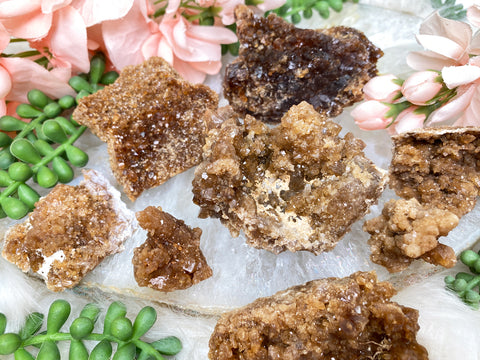
Citrine is a beloved birthstone for those born in the cheerful month of November. As the citrine birthstone, it brings a burst of warm, golden energy to celebrate the autumn season. Its vibrant hue is said to symbolize abundance, prosperity, and positive energy, making it a meaningful and cherished gem for November-born individuals. Citrine birthstone jewelry is not only a stylish accessory but also a personal talisman, believed to bring good fortune and abundance into the wearer's life. Whether adorning a pendant, ring, or earrings, citrine birthstone jewelry or citrine crystals is a beautiful way to embrace the positive vibes and sunny disposition associated with this gemstone.
Can Citrine Go In Water?
Can citrine go in water? Citrine is generally safe to be placed in water, but there are some considerations to keep in mind. Citrine is a variety of quartz, and while it doesn't readily dissolve in water, prolonged exposure to water may affect its appearance over time due to water deposits and etching if under strong currents. It's especially important to note that citrine, like other crystals, can be sensitive to sunlight. Extended exposure to direct sunlight can cause its color to fade. Therefore, if you choose to place citrine in water, it's best to do so for short periods, and avoid leaving it in direct sunlight for an extended time to preserve its natural beauty. But quite rinses from daily wear or to cleanse, no problem having citrine in water!

More about Citrine
Additionally, Citrine stone is believed to help assist in manifesting and achieving goals. It is common for Citrine money trees to be placed around the home to welcome abundance, prosperity, and positivity. You can also place a Citrine in the ‘Prosperity Corner’ of your home or workspace. This would be the back left corner of the building (when facing the front door from outside).
Citrine is a 7 on the Mohs hardness scale, making it harder than a steel nail. Although hard, Citrine can be brittle and may break easily.
Chakra: Root, Sacral, and Solar Plexus
Citrine Localities: Brazil, DR Congo, Russia, India, Madagascar, Sri Lanka and the United States
Birthstone: Alternative for November



